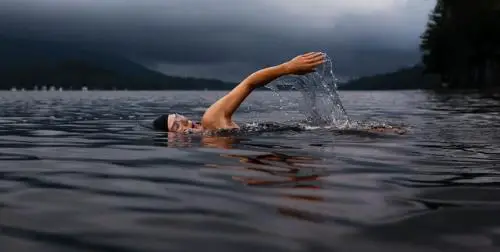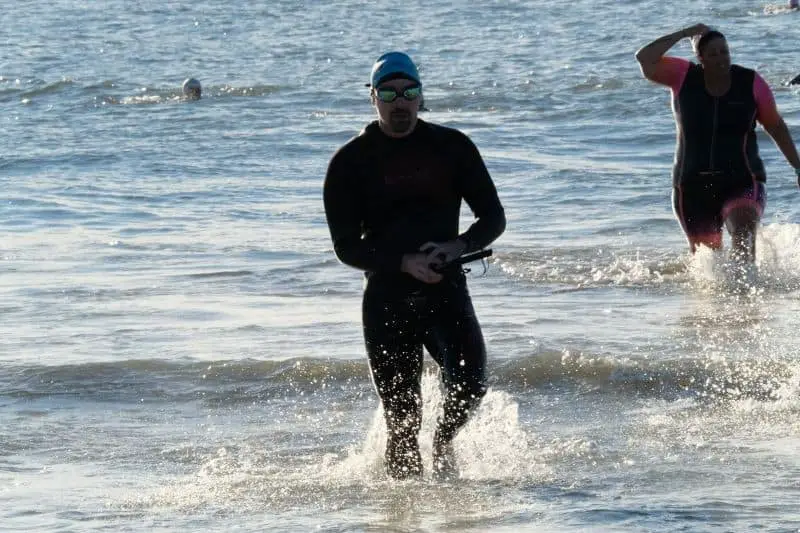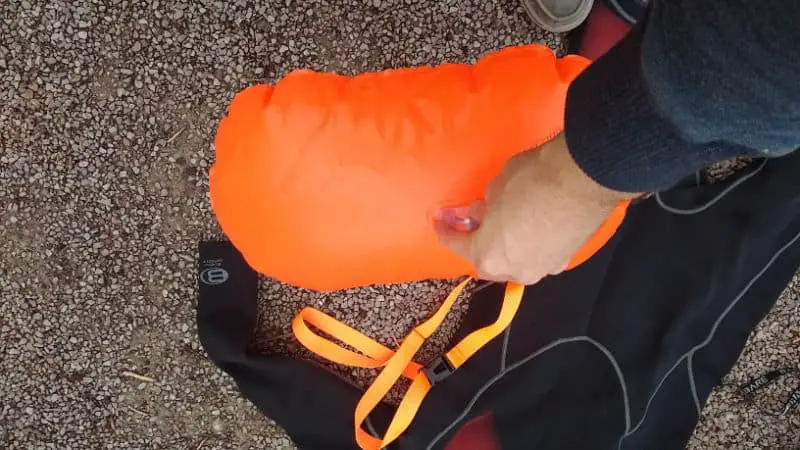

Andy is a jack-of-all-adventures, master of none. Depending on the season, you might find him rock climbing, trail running, kayaking, skiing, mountain biking, surfing or good ol’ hiking.

This Gear Guide List is for anyone interested in becoming an open water swimmer! Great for people wanting to cross lakes, flatwater rivers, and simple ocean swims. You don’t have to be a great athlete to enjoy swimming el naturel!
(If you’re planning on swimming the straits and channels of the Oceans Seven, dare I suggest you might find this guide … a bit rudimentary?)

As you can imagine, open water swimming has its dangers. The obvious hazard is drowning. You also don’t want to get chewed up by a speedboat propeller or thunked with a SUP. Or a bacterial infection from polluted water. Don’t assume all water found in nature is “natural” water! Oh, and lastly, not all public bodies of water are open to swimming. If you choose to break the law, cross your fingers local law enforcement can’t paddle as fast as you can!
I am not a fish. I groked the basics of swimming as a pre-teen and proceeded to happily flail through the water for the next 20 years. If I could get to the other side of a 50-meter pool without puking up a half-gallon of chlorinated water, I was doing well.
Then I signed up for a half Ironman, a 70.3-mile endurance triathlon that required swimming 1.2 miles through the open ocean. Faced with the daunting challenge of swimming for up to an hour non-stop, I had some work to do!
Turns out, I loved open water swimming! It’s not like swimming in a pool. The open water is to swimming what mountaineering is to the treadmill: Same activity, wildly different experience!
I loved the feeling of diving into a lake and emerging from the other side an hour and a half later. I felt like the Loch Ness Monster, popping up sporadically to shock and surprise passing kayakers, wind-surfers, and paddle-boarders.
Open water swimming can take place in any body of water:
Lakes are the easiest. River swimming and ocean swimming require specialized skills and are exponentially more dangerous.
But once you’ve mastered the fundamentals, you can embark on swimming tours all over the world! Does anyone else want to swim 12.5 miles around Key West?
Here’s an excerpt from my guide to the Ironman 70.3 triathlon:
“I found the following four YouTube channels to be INCREDIBLY helpful:
They’ll teach you all about how to streamline in the water, how to efficiently catch and pull, how to breathe in open water, and how to note waste energy while kicking.
Here’s what I’d add or highlight:
- Your kick ain’t sh*t! The purpose of your kick is only to rotate your body and prevent your legs from sinking. So don’t overdo it.
- Speed comes from technique. Don’t waste energy pulling too hard. Just swim smooth.
- You’ll probably forget to practice sighting. I did.”
And as I also talked about in my Ironman article, there’s no shame in practicing with a snorkel! It’s a great way to log mileage.
| DESCRIPTION | COST ESTIMATE | NOTES |
|---|---|---|
| REQUIRED | ||
| Just you! | $0 | Your inner European, as it were. |
| RECOMMENDED | ||
| Swimsuit | $20-$50 | No boardsuits or bikinis. Wear something Spandex-y, athletic. |
| Wetsuit | $50 (Used) - $300 | 3mm max! - unless cold-water swimming. |
| Goggles | $20 - $50 | Tinted and polarized. |
| Swim Cap | $5 | Brightly colored for protection. |
| Swim Buoy | $25 | Brightly colored for protection. Alternative: Anti-drowning bracelet. |
| Sunscreen | $5 | SPF 30+, water-resistant. |
| Lubricant | $5 | To prevent chafing. |
| OPTIONAL | ||
| Ear Plugs | $2 | No one likes clogged ears! |
| Swimmer’s Snorkel | $30 | Recommend snorkel with purge valve. Practice in the shallows first! |
| Nose Clip | $7 | Essential if you’re snorkeling. |
| Waterproof Watch | $20 - $200 | For timing and emergency navigation. |
| Sinus Stuff | To alleviate sinus suffering. | |
| Energy Gel | $1 | For 1-hr+ swims. |
Other places on the web will tell you, in great detail, just what makes a wetsuit good or bad. I shall not rehash their advice. If you’ve never worn a wetsuit before, check out this guide.
I would only add this: Buy used. Find three used wetsuits on Ebay, buy three of them, and keep the one that fits the best. Return the others. People commonly grow out of their wetsuits, so there are plenty on the aftermarket!
Don’t settle for the wrong wetsuit!

I’m not a professional swimmer. My experience with swimming goggles is limited to just three brands: Aegend, Speedo, and TYR.
I do have awful eyesight, though. I bought the Aegend goggles off Amazon, and guys, for $15, you basically get a pair of prescription swimming goggles!
Many Amazon viewers complain that things look fuzzy underwater, but just as many complain that the goggles magically improved their eyesight. If you’re nearsighted, like me, then apparently the Aegend goggles partially correct your vision underwater!
All the anti-fog coatings eventually wear off, so bring your own anti-fog spray.

A swim buoy is a critical piece of gear. Never venture into open water without one!
Personally, I don’t float naked – not unless I inhale into a human helium balloon, anyway. I’m more of an ectomorph. So I’m like a shark; I stop swimming, I sink. I would virtually never venture into open water without a swim buoy.
The classic swim buoy buckles around your waist with a belt loop and floats behind you on an extendable tether. No, it doesn’t get in the way. I honestly never noticed it was even there!
I like swim buoys with an adjustable tether. Keep the tether short, and the buoy will automatically keep your head above water when you tread water in place. Keep the tether long, and you can dive a few feet down, if you please.
An alternative to a swim buoy is an anti-drowning swim bracelet. These nifty devices are like mini airbags. In an emergency, you activate them with an attached CO2 cylinder, which instantly inflates the grab bag.
I almost bought one, but the convenience of a swim buoy won me over. An inflatable swim bracelet is a one-shot emergency fix, unlike a swim buoy, which is there whenever you need it!

Wear a brightly colored swim cap that completely covers your ears. You don’t earn any points for fashion. You don’t want to get over by a jet ski, stabbed by a kayak or minced by a motor boat, do you? Wear something loud and obnoxious: Think neon green or hunter’s orange.

Yes, a swimmer’s snorkel is cheating. But it’s awesome.
If you want to enjoy a long-distance swim without spending half your time looking at bubbles and horizon lines, then a swimmer’s snorkel is just the ticket!
Unlike a diving snorkel, a swimmer’s snorkel ascends the middle of your head, curving around your nose and facing backwards, towards your body. The snorkels are attached to your head with a simple adjustable silicone strap.
Pool snorkels must be just a tube plus strap. Open-water snorkels, which I highly recommend, add a purge valve. By exhaling hard into a purge valve, you can get rid of water that leaks into the snorkel from spray, waves, or rain.
Some open-water snorkels come with a top valve that automatically closes when you dive underwater (or a wave crashes over you). These are useful in choppy water, but be aware they do restrict your airflow!
Some people hate snorkels. Some people love them. Some people wear them because they have neck or shoulder mobility issues.
I swam many miles with one, and I don’t regret it. Training with a snorkel allowed me to push my muscles and focus on my stroke, not just my breathing technique. Once bilateral breathing finally clicked, my body was ready for the challenge!

I love swimming in the lake. But I’m not the only creature there! Bass, crawdads, jellyfish, algae, motor oil – lakes are full of life and detritus! And most of that stuff will wind up in your sinus cavities. Gross.
To relieve any sinus symptoms:

Any repetitive motion can cause chafing. Open water swimming can cause chafing in your groin area. If you’re wearing a wetsuit, other problem areas include the chest and nipples, hips, neck line and wrists.
So don’t be stingy with the lubricant! You can use petroleum jelly, baby oil, BodyGlide, Slippy, or a dozen other branded non-greasy, non-oily lubricants. Pick your favorite and be generous with it!
Copyright 2021 – Adventure on the Cheap (SRVS)
